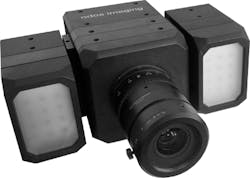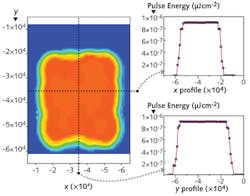Advances in Imaging: Pulsed laser illumination enables high-resolution 3D imaging
RITCHIE LOGAN AND KIRSTY WALLS
Technological developments within the machine-vision industry have historically led to increased quality and efficiency in the manufacturing sector, particularly when coupled to robotic automation of processes. Traditionally, a machine-vision system would focus on capturing and analyzing visible images, so-called intensity images, producing an image readily interpreted by humans as well as machines. However, an increasing awareness of the economic benefits brought by machine vision has driven an expansion of imaging products, and potential areas of application, away from intensity-only imaging.
Technologies such as 3D imaging, in which each pixel in an image conveys the depth, or range, to its corresponding object within the scene, are becoming more widespread and driving growth within the industry, particularly as these new imaging approaches can be better suited to machine, rather than human, interpretation.
Time-of-flight imaging is an attractive noncontact approach to measuring depth, requiring an active illumination source to provide an optical signal used to probe the scene of interest and extract depth information. Time-of-flight (TOF) systems extract this depth information by measuring how long light takes to travel from illumination source to objects in the scene and back to an image sensor contained within the system.
Typical approaches to TOF imaging have often included illumination that is periodically modulated, in conjunction with an image-sensor pixel architecture capable of demodulating the reflected signal. This demodulation of an optical signal can then be used to extract the phase change of the optical signal, thus measuring distance.
odos imaging has developed TOF 3D imaging systems based on an alternative approach: pulsed illumination. The systems incorporating this approach operate at high spatial resolutions, matching the typical resolutions of intensity-only machine-vision cameras, but crucially providing the benefit of depth measurement at each pixel. Recently released is the first commercially available pulsed TOF system intended specifically for the machine-vision market, a system with a spatial resolution of 1280 × 1024 pixels (see Fig. 1).
Machine vision with depth
As in a traditional machine-vision camera, each pixel is capable of capturing an ambient-light image; here, though, this occurs in conjunction with depth-measurement capability—a concept that can be thought of as machine vision with depth.
Pulsed TOF imaging provides a number of unique benefits. At the application level, system integrators can appreciate the benefits of operation in high ambient light conditions and simple synchronization of multiple systems; however, pulsed illumination is also the key enabler of high-resolution TOF imaging.
At the component level, image sensors are designed to convert optical signals to proportional electrical signals. Engineers at odos imaging have developed systems that can extract TOF information from a measurement of intensity of the reflected pulse, greatly simplifying the requirement of the underlying pixel (see Fig. 2). Software in development can allow the viewpoint of the resulting 3D scene to be rotated.Active circuitry within the modules monitors each laser pulse for compliance with output energy limits, ensuring that the units are Class 1 eye-safe, while the distributed nature of the individual laser diodes allows multiple modules to be stacked to increase optical signal and hence increase precision of measurement, while maintaining Class 1 certification. Latency within the modules, from standard trigger input, is on the order of several tens of nanoseconds with almost negligible jitter and fast rise times.
The resulting optical signal provides the basis for accurate measurement of depth within the TOF sensor. Separation of the illumination source from the sensor at the module level enables multiple configurations to be assembled, allowing direct targeting of the desired application.
As is generally the case with optical measurement systems, accumulation or averaging of multiple measurements can improve the overall precision of measurement. Direct accumulation at the sensor is made possible by capturing multiple short exposures of the scene at a fast frame rate, each illuminated by a repeating optical pulse. Extremely good reproducibility between sequential optical pulses is required for this approach to be successful, with less than a 1% change in parameters such as optical rise-time and pulse amplitude.
New applications
High-resolution TOF imaging systems open new applications to the benefits of machine vision. Typically, early adopters for the technology are found in scenarios where the multiple requirements of high resolution, outdoor operation, and flexible implementation are present.
As an example, in the agricultural sector, the drive to more efficiently produce crops has led to automated crop measurement and robotic harvesting systems. Knowledge of crop size can be used as an input to adjust feed or fertilizer application and must generally be taken outdoors in high ambient light conditions.
Similarly, the continued growth and integration of the logistics sector (which handles the point-to-point flow of goods) are enhanced by the ability of 3D imaging systems to quickly and efficiently capture a dimensional snapshot of objects or parcels. It also offers the potential for additional features such as bar-code recognition or security images to be captured.
Nontraditional applications outside of manufacturing facilities provide a growth opportunity within the vision industry, and look to be the sectors most ready to take advantage of the machine vision with depth approach.
Ritchie Logan is VP, business development, and Kirsty Walls is senior electro-optics engineer at odos imaging, Scottish Microelectronics Centre, Edinburgh, Scotland; email: [email protected]; www.odos-imaging.com.

![FIGURE 2. An example scene with 3D information shows the intensity image (left) and the depth image (right) [false color, 816 × 600 resolution]. FIGURE 2. An example scene with 3D information shows the intensity image (left) and the depth image (right) [false color, 816 × 600 resolution].](https://img.laserfocusworld.com/files/base/ebm/lfw/image/2016/01/1410lfw_f5_fig2.png?auto=format,compress&fit=max&q=45&w=250&width=250)
